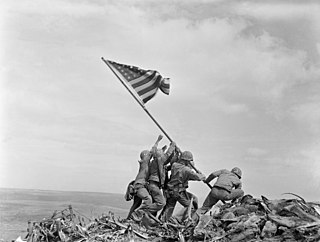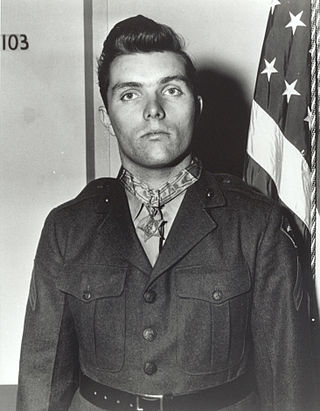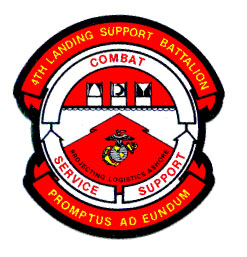
The Battle of Iwo Jima was a major battle in which the United States Marine Corps (USMC) and United States Navy (USN) landed on and eventually captured the island of Iwo Jima from the Imperial Japanese Army (IJA) during World War II. The American invasion, designated Operation Detachment, had the goal of capturing the island with its two airfields: South Field and Central Field.

The 4th Marine Division is a reserve division in the United States Marine Corps. It was raised in 1943 for service during World War II, and subsequently fought in the Pacific against the Japanese. Deactivated after the war, the division was re-formed in 1966 and elements of the division deployed during the Gulf War in 1990–1991, as well as during the Iraq War. It is currently the ground combat element of the Marine Forces Reserve and is headquartered in New Orleans, Louisiana, and has units throughout the United States.

The 5th Marine Division was a United States Marine Corps ground combat division which was activated on 11 November 1943 at Camp Pendleton, California during World War II. The 5th Division saw its first combat action during the Battle of Iwo Jima in 1945 where it sustained the highest number of casualties of the three Marine divisions of the V Amphibious Corps. The 5th Division was to be part of the planned invasion of the Japan homeland before Japan surrendered. Assault troops of the 5th Division were included in the Presidential Unit Citation awarded to the V Amphibious Corps for extraordinary heroism on Iwo Jima from 19 to 28 February 1945. The 5th Division was deactivated on 5 February 1946.

The 25th Marine Regiment is one of two infantry regiments in the 4th Marine Division of the United States Marine Corps. From its headquarters in Fort Devens, Massachusetts, the regiment commands fifteen training centers in nine states throughout the Northeast. These units consist of approximately 3,500 reserve and active duty Marines and are located from Maine to Delaware, West Virginia and as far west as Ohio. The 25th Marines is primarily a cold weather regiment and frequently trains in northern Norway.

2nd Battalion, 24th Marines (2/24) is an infantry battalion in the United States Marine Corps based out of Chicago, Illinois, consisting of approximately 1000 Marines and Sailors. The battalion falls under the 23rd Marine Regiment and the 4th Marine Division.

Joseph Jeremiah McCarthy was a mustang officer in the United States Marine Corps Reserve, who served during World War II and the Korean War. He was also the Superintendent of Ambulances in the Chicago Fire Department; however, with respect for his wartime heroics, firefighters continued to address him by his wartime military rank of “Captain.”

The 2nd Battalion, 25th Marines (2/25) is a reserve infantry battalion in the United States Marine Corps.

The 23d Marine Regiment is a reserve infantry regiment of the United States Marine Corps. It is headquartered in San Bruno, California and falls under the command of the 4th Marine Division and the Marine Forces Reserve.

1st Battalion, 23rd Marines (1/23) is one of 32 infantry battalions in the United States Marine Corps, and one of only eight battalions found in the reserve. It is located throughout Texas and Louisiana consisting of approximately 1000 Marines and Sailors. They fall under the command of the 23rd Marine Regiment and the 4th Marine Division.

2nd Battalion, 23rd Marines (2/23) is a reserve infantry battalion in the United States Marine Corps located throughout the Western United States consisting of approximately 1000 Marines and Sailors. They fall under the command of the 23rd Marine Regiment and the 4th Marine Division.

3rd Battalion, 23rd Marine Regiment (3/23) is a reserve infantry battalion in the United States Marine Corps located throughout the Southern United States consisting of approximately 800 Marines and Sailors. The battalion was first formed in 1943 for service in the Central Pacific Area during World War II, taking part in a number of significant battles including those at Saipan and Iwo Jima before being deactivated at the end of the war. In the early 1960s, the unit was reactivated as a reserve battalion. The battalion is headquartered in Saint Louis, Missouri, with outlying units throughout the Southern United States. 3/23 falls under the command of the 23rd Marine Regiment and the 4th Marine Division. Recent operations have included tours in Iraq and Afghanistan.

3rd Battalion, 24th Marines (3/24) was a reserve infantry battalion in the United States Marine Corps. The battalion was first formed in 1943 for service in the Pacific Theater of Operations during World War II, taking part in a number of significant battles including those at Saipan and Iwo Jima before being deactivated at the end of the war. In the early 1960s, the unit was reactivated as a reserve battalion. It was located throughout the Midwestern United States and consisted of approximately 800 marines and sailors. The battalion was part of the 24th Marine Regiment and the 4th Marine Division. Recent operations included tours in Iraq and Afghanistan. On May 19, 2013, the battalion was deactivated (retired) as a part of 2013 Marine Corps Force Restructuring, along with the 24th Marine Regiment. 3/24 personnel were reallocated to 23rd Marine Regiment, with the majority of the companies becoming 3rd Battalion, 23rd Marines.

The 9th Marine Regiment was an infantry regiment of the United States Marine Corps. Formed during World War II, it served until 1994, when it was deactivated during the post Cold War drawdown. Battalions of the Ninth Marine Regiment, but not the regiment itself, were reactivated from 2007 to 2014 as part of the Marine Corps' growth during the wars in Iraq and Afghanistan. The battalions have subsequently been deactivated again.

Major Douglas Thomas Jacobson was a United States Marine who earned the United States' highest military honor — the Medal of Honor — for his heroic actions on Iwo Jima during World War II. "Private First Class Jacobson destroyed a total of sixteen enemy positions and annihilated approximately seventy-five Japanese, thereby contributing essentially to the success of his division's operations." He was presented the Medal of Honor by President Harry S. Truman on October 5, 1945.
In anticipation of the Battle of Iwo Jima, Lieutenant General Tadamichi Kuribayashi prepared a defense that broke with Japanese military doctrine. Rather than defending the beaches, Kuribayashi devised a defense that maximized enemy attrition. The American plan of attack was made in anticipation of a standard defense.

20th Marine Regiment was a Composite Engineer Regiment of the United States Marine Corps that fought during World War II.

4th Landing Support Battalion(4th LSB) was a Military Landing Support battalion of the United States Marine Corps Reserve. The unit was based out of New Orleans, LA, Savannah, GA, and Charleston, SC, and fell under the command of the 4th Marine Logistics Group. The Battalion has been decommissioned.

Naval Mobile Construction Battalion 133 is a United States Navy Construction Battalion, otherwise known as a Seabee battalion, homeported at the Naval Construction Battalion Center. The unit was formed during WWII as the 133rd Naval Construction Battalion. It saw action and was decommissioned shortly after the war ended. The unit was reactivated as Mobile Construction Battalion 133 for the Vietnam War and remains an active unit today.

George Davis Webster was a decorated officer of the United States Marine Corps with the rank of brigadier general who is most noted as commanding general, Marine Corps Development and Education Command at Quantico, Virginia.

Frank Edmund Garretson was an American military officer who served in the United States Marine Corps with the rank of brigadier general. A veteran of World War II, he distinguished himself as commanding officer of Company F, 2nd Battalion, 24th Marines, 4th Marine Division during the attack on Namur Island, Kwajalein Atoll, on February 1–2, 1944 and received the Navy Cross, the United States' second-highest decoration awarded for valor in combat.
























